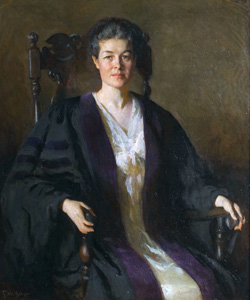
King, Lida Shaw (1868 - 1932)
Role: Third Dean of the Women's CollegeDates: 1905 - 1920
Portrait Location: Alumnae Hall 104
Artist: Benson, Frank Weston (1862 - 1951)
Portrait Date: 1913
Medium: Oil on canvas
Dimensions: 35 1/2
Framed Dimensions: 48
Brown Portrait Number: 108
Brown Historical Property Number: 431
Lida Shaw King was a classical scholar and one of the pioneers in early 20th century women's higher education. Born to the family of a Baptist minister in Boston and descended from Mayflower pilgrim, John Alden, King fit in well at Brown University, where a stringent preference for New England Baptists remained the rule until 1926. The youngest of three daughters, her father was the pastor of the First Baptist Church in Providence from 1891-1906.
As an ambitious female scholar in an era when the vast majority of women were full-time homemakers, however, King was more often conspicuous on the academic landscape. In the pursuit of a higher education and an academic career at a time when such aspirations were rare and unconventional for women, she had to struggle against her father's opposition in realizing her plans. Indeed, her predecessor at Brown's Women's College stepped down upon marriage to remain at home (BP 109). King graduated from Vassar College in 1890, and then went on to earn a Master of Arts degree from Brown in 1894, the first year women were awarded degrees. King pursued graduate work in classics at both Vassar and Radcliffe Colleges until 1898, when she became a teacher in, and later director of, the Department of Greek and Latin at the Packer Collegiate Institute. In 1899 she was awarded the prestigious Bryn Mawr Fellowship to study at the American School of Archaeology in Athens. She returned to Athens again the following year as an Agnes Hoppin Memorial Fellow. King and former student Ida Thallon became the first women to conduct an archaeological dig on mainland Greece, and in 1903 King published an article in the Journal of the Archaeological Institute based on their excavations in a cave mythically associated with Pan and the nymphs.
In 1905, King was invited to Brown as the third dean?and second female dean?of the Women's College, and was offered an assistant professorship. She was named full professor of classical literature and archaeology in 1909, becoming the lone woman on a university faculty of over a hundred men. King excelled not only in scholarship and teaching, but in administration as well. During her fifteen years as Dean of the Women's College, she increased its funding five fold, and enrollments more than doubled. In addition, under her leadership, two new dormitories were built on campus, and the Rhode Island Society for the Collegiate Education of Women allotted her a discretionary fund for social and cultural events. Her work at the Women's College was consistent with her goals of bringing more women into higher education and improving the standards of women's education. King was awarded honorary degrees from Mount Holyoke College (Litt. D., 1912) and from Western Reserve University (LL.D., 1913).
In 1922, King retired and President Faunce reported that she planned "to return to Greece to pursue her favorite studies in classical archaeology." In fact, it was mental illness that had cast its shadow on a brilliant career, a shadow that grew deeper in the decade to come. King never returned to Brown, and died in 1932. During a memorial service at the Women's College (renamed Pembroke College in 1928), a letter from one of her former students was read aloud:
"She is in my memory a flower, with sweetness and graciousness so delicate that not everyone could appreciate her charm, and at the same time with an inner austerity in her demands on herself that half awed the young cubs that we were. I could always go to her for impartial justice, for a strengthening of my aspirations toward gentle living; but a frank rebuke was sure to meet anything that fell below the high standard she set for herself and us....I've always been glad that the portrait presented to the college represented her at her sunny and gracious best."
Martha Mitchell, in her entry about Lida Shaw King in the Encyclopedia Brunoniana, quotes a passage from a memorial address by Albert Davis Mead, professor of biology and vice-president of the university, who refers to the significance of King's portrait:
"Those of us who were her colleagues, and who remember with regret, but with understanding, the slow encroachment of the shadow of illness that darkened her later years, are especially glad that we have the remarkable portrait of Dean King ? this portrait recalls her characteristic vivacity, keen intelligence, and aristocratic refinement."
Frank Weston Benson, one of the most important American Impressionist painters, painted this portrait two decades earlier while King was in her prime. As the above quote illustrates, King's likeness was referred to repeatedly throughout her memorial service, and it remains at Alumna Hall where she dedicated herself to women's education. Benson is best remembered for his images of contemplative young ladies, and he specifically chose subjects, such as King, who he believed represented civilized ideals of grace, dignity, and elegance. Benson was born in Salem, Massachusetts, and studied at the School of the Museum of Fine Arts in Boston. Out of love for the northeast coast, he established a farm-studio on North Haven Island off the coast of Maine.
